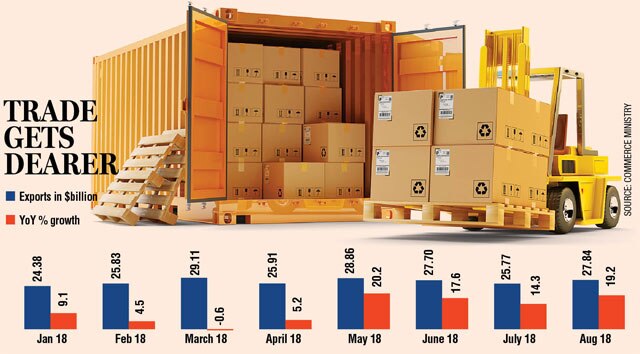The Government's hasty measures to stem the rupee slide has not paid off as the currency weakened further by at least 1% to over Rs 72.5 to a dollar as the new week began.
Analysts have warned against such actions as it's not just the rupee, but other emerging market currencies too have depreciated against the strengthening dollar.
The rupee has been appreciating over the last 3-4 years due to government policies which also led to huge imports as well. Some course correction was therefore needed to reverse the overvalued rupee.
The government appears to be panicking which is not good at it sends a wrong signal to both domestic and foreign investors.
For the last four-and-a-half years, India lost the golden opportunity to reform exports in view of a global recovery.

The government implicitly pursued strong rupee policy, which was not good for the economy.
This resulted in real rupee value appreciating nearly 20% over the past 3-4 years because the government felt that stronger rupee meant a stronger economy.
One immediate example that comes to my mind is sugar. India had a bumper production and global prices are conducive. This provided an opportunity to make a kill on sugar exports. The oil imports are posing problems but the government is sitting pretty because it is getting additional revenue. Also energy cost for industry is hardly 4-5% barring energy-intensive aluminium. So overall, it should not be inflationary.
The current account deficit is widening because of two reasons -- demonetisation and hasty rollout of goods and services tax (GST). These measures impacted the informal sector badly, which accounted for nearly 80% of the jobs in the country.
India's CAD has been hit on both counts – low exports and high imports. But this does not mean the government should make efforts to control imports. Instead, it should step up exports through massive reforms, take steps to attract labour-intensive export units which are shifting base from China. At the moment most of them are going to Vietnam, Cambodia, Bangladesh and so on.
Both Khullar and Federation of Indian exports organisation are saying that import controls will not help in finding a permanent solution to tackle the problem. India needs to boost exports.
The government recently announced measures to attract additional capital inflows of $8-10 billion to manage the external situation. It also eased external commercial borrowing norms.
Kotak Mahindra Bank economist Upasana Bharadwaj was not sure how much capital flow will come from these measures and felt no panic reactions were needed at this stage. The market sentiments and a further slide in rupee have proved this point.
The best way to stem the rupee slide is to stop the panic, The government's measures to mop up $8-10 billion are sending wrong signals to investors. "This is a sort of self-goal," The government should allow the market to tide over the situation.
The appreciation of rupee value has also contributed to cheap imports during the last 3-4 years, which has now started showing up. This has resulted in widening trade and current account deficit, Sen said.
More than demonetisation, the rollout of GST had badly impacted small exporters, who account for nearly 45% of India's exports. The refunds are not forthcoming quickly and this has starved small exporters of working capital.
Even with current account deficit at 2.5% of GDP, India could still grow at 8%.
According to former RBI governor Raghuram Rajan, falling rupee is not too big a worry right now. He feels it has not depreciated to a worrying level. The rupee has weakened nearly 10% so far this year making it the worst performing Asian currency.
India should focus on strengthening its macroeconomic fundamentals instead of worrying about the depreciating rupee.
However reining-in current account deficit and maintaining fiscal deficit is more important than sending wrong signals to investors that may shatter their confidence at a time when the economy is getting kick-started.